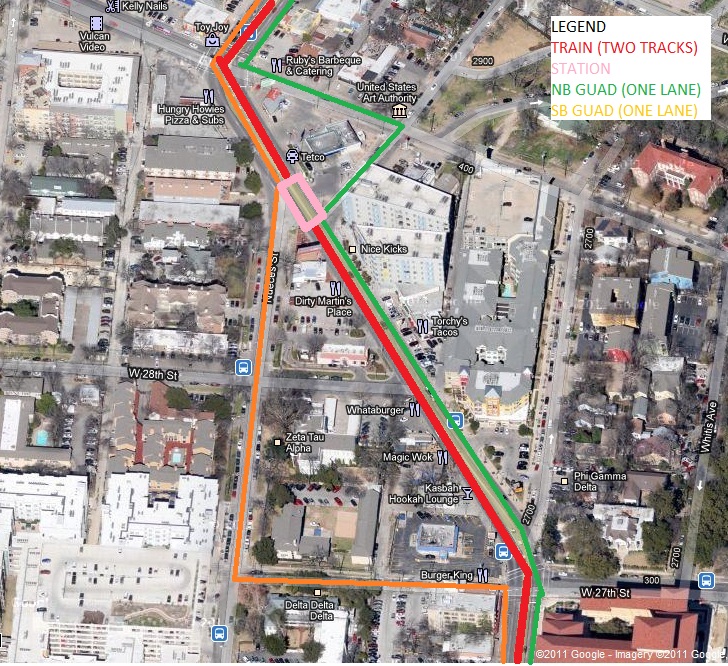I’ve thrown this argument and picture around a hundred times, but have probably never put them together into a single post, so here we go.
The 2000 light rail proposal had one section that was particularly problematic: where Guadalupe narrows to 4 skinny lanes between 29th and 27th streets. The ‘solution’ to light rail as envisioned back then by the city and by Capital Metro was something like the picture you see below, but first I’ll explain it.
Light rail, to be any good, needs to run in its own space – free of cars. Also, in a two-way street, this space should be in the middle of the street – so that both directions of travel can share some infrastructure; so stations are easier to locate; etc.
Guadalupe is a wide street – mostly. Especially south of 24th, it would have been possible to keep two train lanes and (likely) two other lanes going each direction – or at a bare minimum, one lane each direction plus the tracks with no real trouble.
Except, again, for 27th to 30th. Right now there’s about 44 feet of right of way there (4 11-foot lanes). This is not enough to safely fit two train lanes and two vehicle lanes, unfortunately.
So what to do? Here’s my really crappy freehand reconstruction from memory of an engineering drawing that was on the wall of our UTC meeting room for several months in 2003, if I remember correctly. As per usual, click to embiggen.
Now, I might be getting northbound wrong here – it might have gone up Hemphill Park, but you get the idea. Both directions of through travel on Guadalupe would have been disrupted by moving to side streets.
Can you imagine trying to sell this to the public?
Well, in 2000 (and 2004, had we not rolled over for Mike Krusee), you could have made this argument:
Carrying 40,000 riders/day (boardings) is a more efficient use of this space than the cars (and buses) are currently able to pull off. An arterial lane like these can carry only 1000-1500 vehicles per hour – and this proposal trades 3 of the 4 through travel lanes for that train capacity. The travel demand in this corridor is highly directional – peak demand generally inbound in the morning and outbound in the afternoon with little reverse commuting. We could reasonably expect to somewhat increase the number of people able to use this corridor by making this change. Given there’s somewhere in the high single digit of thousands of boardings for buses in this corridor now, a safe estimate might be that you could almost double(*1) the people moved on the corridor by adding light rail that went directly from the suburban park-and-rides through the urban core into downtown.
Now move to 2012, and try to imagine making the same sale, in the world where the Red Line exists. Except those 40,000 boardings/day are nowhere in sight – because a lot of those people were suburban park-and-ride passengers who won’t ride a service that requires them to transfer (yes, even from train to train); and a few of the urban passengers who would be going up to suburban destinations. I think a reasonable estimate for ridership in this corridor, if we did what Lyndon Henry now wants and just built a stub urban rail line from the 2000 plan, would be 20,000 boardings/day. In other words, most of the urban ridership of the 2000 proposal plus the current Red Line riders. Is it worth the incredible disruption now – when you’re probably just adding a couple of thousands of boardings/day to the corridor?
No, sad to say, it is not.
And that, in addition to the political problems relating to Rapid Bus (see future post), is why we will never see rail in front of UT in our lifetimes. The key lesson here is that the entire reason I fought the Red Line in 2004 is precisely because it meant we couldn’t get rail later on Guadalupe (where it needs to be) if we built it. See here: Don’t Kid Yourself: Commuter Rail Precludes Light Rail, although that post emphasizes more of the technical and Rapid Bus related issues. I did warn people – if you start with the Red Line, you don’t get rail on Guadalupe, period.
(1: Yes, I could do the math. No, I don’t have time now. I did it on a piece of notebook paper back in the 20-oughts. You’ll have to trust me, or go look it up yourselves.)
